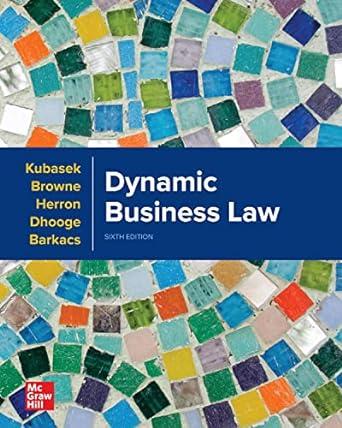Plaintiff Stephanie Crowley Brennan sued her employer for sexual harassment. At trial, plaintiff testified that an August
Question:
Plaintiff Stephanie Crowley Brennan sued her employer for sexual harassment. At trial, plaintiff testified that an August 2004 email was the only incident of harassment based on her gender directed at her. Although the August 2004 email, which referred to plaintiff as a “big-titted, mindless one” (although it did not mention her by name), was rude, insulting, and unprofessional, the record shows it was an isolated event as there was no evidence that the sender (or any employee of the agency) made any other derogatory remarks about plaintiff, sex based, or otherwise, in any other context. The evidence showed the email was not intended to be shared publicly. Instead, it was indisputably intended to have been only sent to one person. Plaintiff saw the August 2004 email only after it was inadvertently forwarded to another employee, who in turn forwarded it to plaintiff. Plaintiff was a vice president of the agency at the time of the August 2004 email, and the author of the email was never her supervisor. A jury found that plaintiff was subjected to severe or pervasive harassment based on her gender, in violation of Gov. Code, § 12940, of the Fair Employment and Housing Act. The Superior Court of Orange County, California, granted defendant employer’s motion for judgment notwithstanding the verdict, and the employee appealed.
JUSTICE FYBEL Like federal law, California law prohibits sexual harassment in the workplace. With respect to sexual harassment in the workplace, the prohibited conduct ranges from expressly or impliedly conditioning employment benefits on submission to, or tolerance of, unwelcome sexual advances to the creation of a work environment that is hostile or abusive to employees because of their sex. Thus, similar to the federal law’s Title VII, California’s FEHA recognizes two theories of liability for sexual harassment claims, quid pro quo harassment, where a term of employment is conditioned upon submission to unwelcome sexual advances and hostile work environment, where the harassment is sufficiently pervasive so as to alter the conditions of employment and create an abusive work environment.
In construing California’s FEHA, this court has held that the hostile work environment form of sexual harassment is actionable only when the harassing behavior is pervasive or severe. This limitation mirrors the federal courts’ interpretation of Title VII. To prevail on a hostile work environment claim under California’s FEHA, an employee must show that the harassing conduct was severe enough or sufficiently pervasive to alter the conditions of employment and create a work environment that qualifies as hostile or abusive to employees because of their sex. There is no recovery for harassment that is occasional, isolated, sporadic, or trivial. Courts that have construed federal and California employment discrimination laws have held that an employee seeking to prove sexual harassment based on no more than a few isolated incidents of harassing conduct must show that the conduct was severe in the extreme. A single harassing incident involving physical violence or the threat thereof may qualify as being severe in the extreme. Under California’s FEHA, as under the federal law’s Title VII, the existence of a hostile work environment depends upon the totality of the circumstances.
In evaluating the totality of the circumstances to determine the existence of a hostile work environment, the following factors can be considered: (1) the nature of the unwelcome sexual acts or works (generally, physical touching is more offensive than unwelcome verbal abuse); (2) the frequency of the offensive encounters; (3) the total number of days over which all of the offensive conduct occurs; and (4) the context in which the sexually harassing conduct occurred. In determining what constitutes sufficiently pervasive harassment, the courts have held that acts of harassment cannot be occasional, isolated, sporadic, or trivial, rather the plaintiff must show a concerted pattern of harassment of a repeated, routine or a generalized nature.
We begin our analysis by observing the trial evidence did not support a finding plaintiff was ever subjected to severe sexual harassment. Neither the August 2004 email nor any evidence at trial showed plaintiff was ever assaulted, subjected to “unwelcome physical contact,” threatened, propositioned, or subjected to explicit language directed at her or at anyone else in her presence. As plaintiff acknowledged in her own testimony, the August 2004 email was the only sexual harassment she claims she directly experienced up to that time. Evidence of the August 2004 email, even when coupled with evidence of the few other sporadic claimed incidents of sexual harassment she witnessed over the years, her conversations with Steve O’Leary about her personal life, and her discovery of other incidents of sexual harassment that did not occur in her presence or immediate work environment, is insufficient as a matter of law to establish the existence of pervasive harassment based on gender.
Judgment for defendant is affirmed.
CRITICAL THINKING:
Do you agree that Plaintiff had no claim for sexual harassment because the facts did not demonstrate the circumstances were “severe and pervasive”? Should “severe and pervasive” be the standard? Why or why not?
ETHICAL DECISION MAKING:
Do you believe it was ethical for Defendant to suffer no repercussions after referring to Plaintiff as a “big-titted, mindless one”? Why or why not?
Step by Step Answer:

Dynamic Business Law
ISBN: 9781260733976
6th Edition
Authors: Nancy Kubasek, M. Neil Browne, Daniel Herron, Lucien Dhooge, Linda Barkacs





